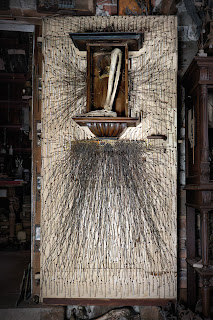 |
| all images courtesy of Matthias Korb |
Located in the small community of Lohrheim, Germany, some 70 km north-west of Frankfurt am Main, above pictured house is home to an art environment in the capacity of a museum, named INITIUM ET FINIS (Beginning and end). As a further indication the complement Wunderkammer der Humanität (Wunderkammer of Humanity) is often added.
The museum, a private affair, was developed from 2008 on, when Matthias Korb bought a house in Lohrheim when he needed more space to further develop his artistic activities, which he had started in 2005.
Life and works
Matthias Korb was born in 1969 in Frankfurt am Main.
Already at a young age he was concerned with man and his place in the system of nature and how that was expressed, for example, in the way gardens were laid out in the era of the Renaissance compared to the contemporary way of working.
By this interest he was inspired to look for a job in the field of landscape gardening. In his late twenties, in 1997, he started his own business in this area.
With the same interest in mind, for a number of years Korb was also involved in publishing books, while in 2005, without any education at an art school, he started to focus on the creation of visual art.
In the early phase of his artistic career. Matthias Korb liked to make assemblies, giving found objects a new meaning by letting nature appear in the background decoration that can consist of a mixture of paint and different forms of earth.
There also is a relation with his job as landscaper in so far that the way he arranges his assemblages corresponds to the way he designs a garden with lines, colors and forms.
In this period Matthias Korb, as a self-taught artist, already participated in various expositions in Germany.
In 2008 Matthias Korb took a different direction in his artistic activities, when he began to transform the various rooms in his house in Lohrheim into an art environment, doing this by adding a variety of items to the interior walls, as shown in the images around...
He gathered these items finding them by chance in nature, during his work, on the dump, but mostly at flea markets in Frankfurt, a town where he often came because of his work.
However, he would also search consciously for specific items if they would fit in with the concept of an assemblage he had in mind to make.
Matthias Korb has been writing so-called life books throughout his life. That is to say: books in which he wrote diary entries, poems, and aphorisms, as well as pasted drawings, pictures, and photos.
Starting in 2014, he began to feature these books in films.
In the years 2023/2024 he worked with a lot of energy, perseverance and creativity on decorating a part of the house in a style that deviates somewhat from the previously followed line.
Of this creative project a video was made, entitled Bewusstsein der Welt, a video that was released in March 1925 (see documentation).
And so the video goes on.
There is a decoration called Dunkle Materie (Dark Matter) and another one named Starke Kernkraft (Strong Nuclear Power), just as there is also a decoration that indicates the boundary of man, where the soulish begins and the corporeal ends.
The images shown in the video are impressive in their generally complex and unusual composition,
so just think about what visitors experience when they see the creations in reality.
What is depicted here in terms of items transcends the everyday, domestic decorative items
and addresses the essence of human life..
The German concept Wunderkammer (Room of wonders) refers to a phenomenon from earlier centuries, when collections were set up -initially by royal people, later also by rich civilians- which included artworks, but also miraculous and everyday things.
However, the use of the Wunderkammer concept is not intended to give shape to longing back to the past. Matthias Korb's art environment is a Gesamtkunstwerk that -using the Wunderkammer concept- investigates the relationship between mankind and all that it surrounds. The expansion of the exhibition with the 2023/2024 creations gives shape to this concept in an inspiring way.
Other than joining this process of ongoing specialization, the Museum Initium et Finis bears witness to a development that is going in a completely opposite direction, that of generalization.
This does not alter the fact that visiting the museum can contribute to thinking about earlier times or about the situation of mankind in the contemporary world. In good weather the garden of the museum offers the visitor a suitable place to reflect about these topics.
 |
| portrait of Matthias Korb |
Documentation
Video
Matthias Korb
can only be visited on appointment, 18 years and older
































